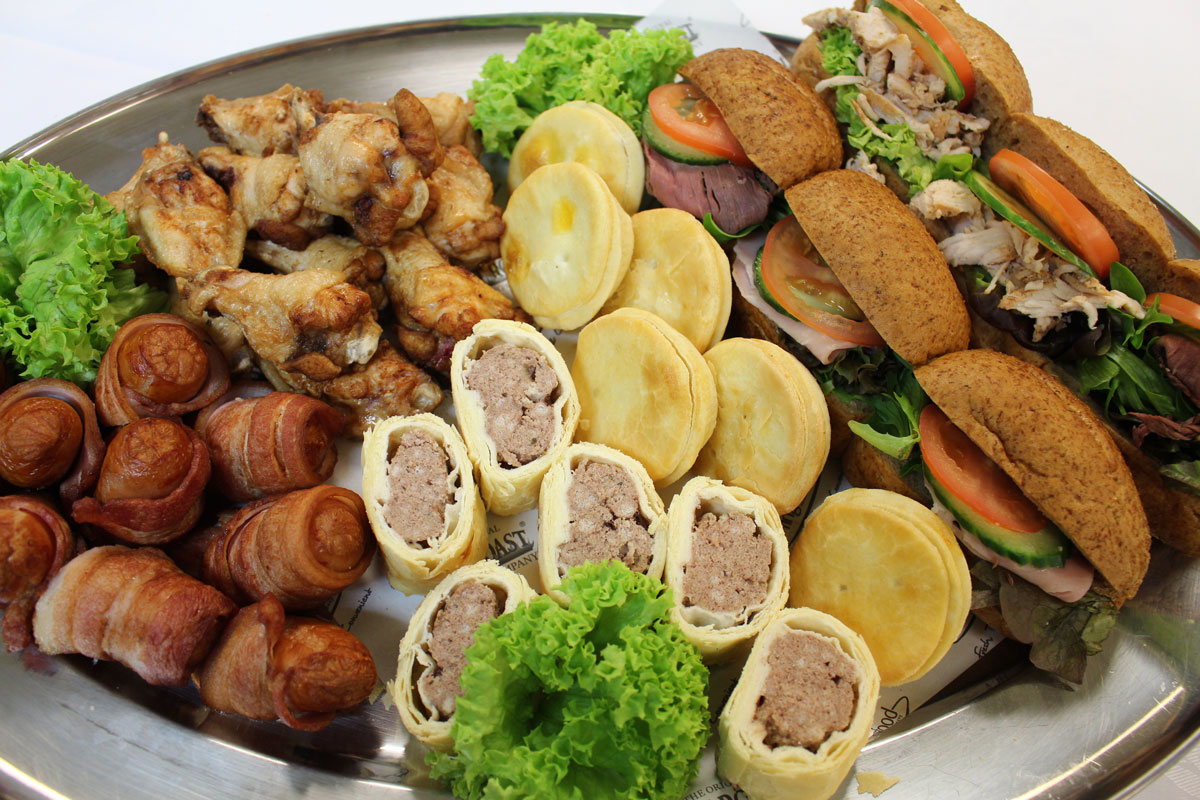Imagine a vibrant spread, bursting with color and flavor, where every guest can indulge without worry. This isn’t just a party; it’s a celebration of delicious, gluten-free culinary creations. From elegant vegan tapenades to hearty vegetarian skewers and decadent dairy-free desserts, we’ll explore a world of party platters designed to impress and delight even the most discerning palate. Discover the secrets to crafting visually stunning arrangements, sourcing the finest gluten-free ingredients, and ensuring safe handling for those with allergies.
This guide dives deep into creating unforgettable gluten-free party experiences. We’ll unveil five unique platter recipes, each catering to different dietary needs, complete with step-by-step instructions and mouthwatering visuals. Learn expert plating techniques, understand crucial food safety guidelines, and master ingredient substitutions to achieve perfect results every time. Prepare to elevate your hosting game to a whole new level of deliciousness and inclusivity.
Ingredient Sourcing and Substitutions for Gluten-Free Baking
Creating delicious gluten-free party platters requires careful consideration of ingredients. The right flour blend and substitutions can make all the difference between a successful, flavorful spread and a disappointing one. Understanding the properties of different gluten-free flours and knowing how to effectively replace common gluten-containing ingredients is crucial for achieving optimal texture and taste.
Common Gluten-Free Flours and Their Properties
Selecting the right gluten-free flour blend is paramount for achieving the desired texture and taste in your gluten-free baked goods. Different flours possess unique characteristics that influence the final product. A balanced blend often yields the best results.
- Almond Flour: A finely ground flour made from blanched almonds, almond flour lends a naturally sweet and subtly nutty flavor to baked goods. Its high fat content results in moist, tender textures, making it ideal for cakes, cookies, and muffins. However, its lack of gluten means it can crumble easily if used alone, so it often requires the addition of other gluten-free flours for structure.
- Rice Flour: Derived from rice grains, rice flour comes in various forms, including white, brown, and sweet rice flour. White rice flour produces a light and airy texture, suitable for delicate items like cakes and crêpes. Brown rice flour offers a slightly nuttier taste and a chewier texture, often used in denser baked goods. Sweet rice flour, also known as glutinous rice flour, contributes to a sticky, chewy texture and is often used in Asian desserts.
- Tapioca Flour (Tapioca Starch): A starch extracted from the cassava root, tapioca flour is primarily used as a thickener and binder. It creates a light, airy texture, similar to cornstarch, but with a slightly more neutral flavor. Tapioca flour is excellent for adding lightness to cakes and cookies, and its ability to absorb liquid makes it suitable for creating crisp crusts and preventing gummy textures.
Gluten-Containing Ingredients and Their Gluten-Free Alternatives
Many traditional baking ingredients contain gluten. Fortunately, suitable alternatives exist to maintain both taste and texture in gluten-free recipes. Careful selection and understanding of their impact are key.
- Wheat Flour: The most common gluten-containing flour, wheat flour provides structure and elasticity to baked goods. Substituting it often requires a blend of gluten-free flours like almond, rice, and tapioca flour, along with xanthan gum or guar gum to mimic gluten’s binding properties. The resulting texture may be slightly denser or more crumbly than wheat-based counterparts, but with careful blending, a pleasing texture can be achieved.
- Wheat Starch: A component of wheat flour, wheat starch adds lightness and tenderness. Cornstarch or arrowroot starch are suitable replacements. Cornstarch produces a slightly sweeter taste, while arrowroot starch offers a more neutral flavor. The impact on the final product will depend on the recipe, but generally, the texture remains similar.
- Breadcrumbs: Used for coating and adding texture, breadcrumbs are easily replaced with gluten-free breadcrumbs commercially available or made from gluten-free bread. The texture and appearance will be very similar to traditional breadcrumbs, though the flavor might vary slightly depending on the type of gluten-free bread used.
- Seitan (Wheat Gluten): A meat substitute made from wheat gluten, seitan presents a challenge to replace. Tofu, tempeh, or mushrooms can partially substitute for its texture and savory quality, although the taste and chewiness will differ. Careful consideration of the recipe and the role of seitan are crucial for selecting the most appropriate substitute.
- Soy Sauce (Often Contains Wheat): Many soy sauces contain wheat. Tamari or coconut aminos are excellent gluten-free alternatives that offer a similar salty, umami flavor. The impact on the final dish is minimal, providing a nearly identical taste experience without the gluten.
Reliable Sources for Gluten-Free Ingredients
Accessing high-quality gluten-free ingredients is essential for baking success. A variety of sources, both online and offline, offer reliable options.
Offline Options: Many grocery stores now dedicate sections to gluten-free products. Health food stores and specialty shops often carry a wider range of gluten-free flours, baking mixes, and other ingredients. Local farmers’ markets may also offer gluten-free options, such as almond flour from local producers.
Online Options: Numerous online retailers specialize in gluten-free ingredients, often offering a greater selection and competitive pricing. These online stores frequently provide detailed product information, customer reviews, and convenient home delivery. Always check for certifications to ensure the products meet the standards for gluten-free labeling.
Dietary Considerations and Allergy Information

Creating delicious and safe gluten-free party platters requires meticulous attention to detail, especially concerning dietary restrictions and allergies. Failing to adequately address these concerns can have serious consequences for your guests and potentially legal ramifications for you. Clear communication and proactive measures are essential to ensure a positive and worry-free experience for everyone.
Clear labeling of all gluten-free party platter components is paramount to prevent accidental cross-contamination and allergic reactions. This is not merely a matter of courtesy; it’s a crucial safety precaution. Imagine a guest with celiac disease unknowingly consuming a trace amount of gluten – the consequences could range from mild discomfort to a severe, life-threatening reaction. Therefore, comprehensive labeling is not optional but a non-negotiable aspect of responsible food handling.
Labeling Procedures for Allergen Information
Creating appealing and informative labels involves more than simply stating “gluten-free.” Each platter item requires a detailed ingredient list, clearly identifying potential allergens. This includes not only the main ingredients but also any added spices, sauces, or garnishes that might contain common allergens such as nuts, dairy, soy, or eggs. Visual appeal is important too. Consider using elegant, easy-to-read fonts on brightly colored labels that contrast well with the platter’s background. A small, clear image representing the food item could further enhance understanding. For example, a picture of a vibrant spinach and artichoke dip alongside its label would instantly communicate the platter’s contents. The label should clearly state “Gluten-Free” prominently, along with the full ingredient list and a statement like “May contain traces of [allergen]” if there’s a possibility of cross-contamination during preparation.
Legal Requirements and Best Practices for Handling Allergens
Legal requirements for handling allergens vary by location, but generally mandate accurate labeling and transparent ingredient information. Many jurisdictions require businesses to clearly identify the top 14 common allergens (milk, eggs, fish, crustacean shellfish, tree nuts, peanuts, wheat, soybeans, sesame, mustard, celery, lupin, mollusks, and sulfites) on food labels. Best practices extend beyond legal mandates. This includes establishing rigorous procedures to prevent cross-contamination during preparation and service. Dedicated gluten-free preparation areas, separate utensils, and thorough cleaning of equipment are essential. Staff training on allergen awareness and safe handling practices is also crucial. For instance, a restaurant could dedicate a specific section of their kitchen exclusively to gluten-free preparation, ensuring complete separation from other dishes. This minimizes the risk of accidental cross-contamination and enhances the safety of gluten-free meals. Furthermore, maintaining detailed records of ingredients and preparation methods can be invaluable in case of any incident or investigation.
Hosting a gluten-free party shouldn’t mean sacrificing flavor or visual appeal. With careful planning, creative presentation, and the right recipes, you can create a truly memorable event that caters to everyone. From the vibrant colors of carefully chosen ingredients to the elegant arrangement of each platter, the focus is on a holistic sensory experience. Remember, it’s about more than just food; it’s about creating a welcoming and inclusive atmosphere where everyone feels comfortable and celebrated. So, gather your ingredients, unleash your creativity, and get ready to host the most delicious gluten-free party yet!
Key Questions Answered
What are the best ways to store leftover gluten-free party platters?
Store leftovers in airtight containers in the refrigerator for up to 3 days. Ensure proper labeling to avoid cross-contamination.
Can I prepare gluten-free party platters ahead of time?
Many components can be prepped in advance. Prepare dips, chop vegetables, and bake elements a day or two before the party, storing them correctly to maintain freshness and quality.
How can I ensure my gluten-free party platters are visually appealing?
Use a variety of colors, textures, and heights. Consider using decorative platters, garnishes, and edible flowers to enhance the presentation.
What if a guest has a severe allergy not accounted for in my platters?
Always have a safe, readily identifiable option available for guests with severe allergies. Clearly label all ingredients and be prepared to discuss potential allergens.


